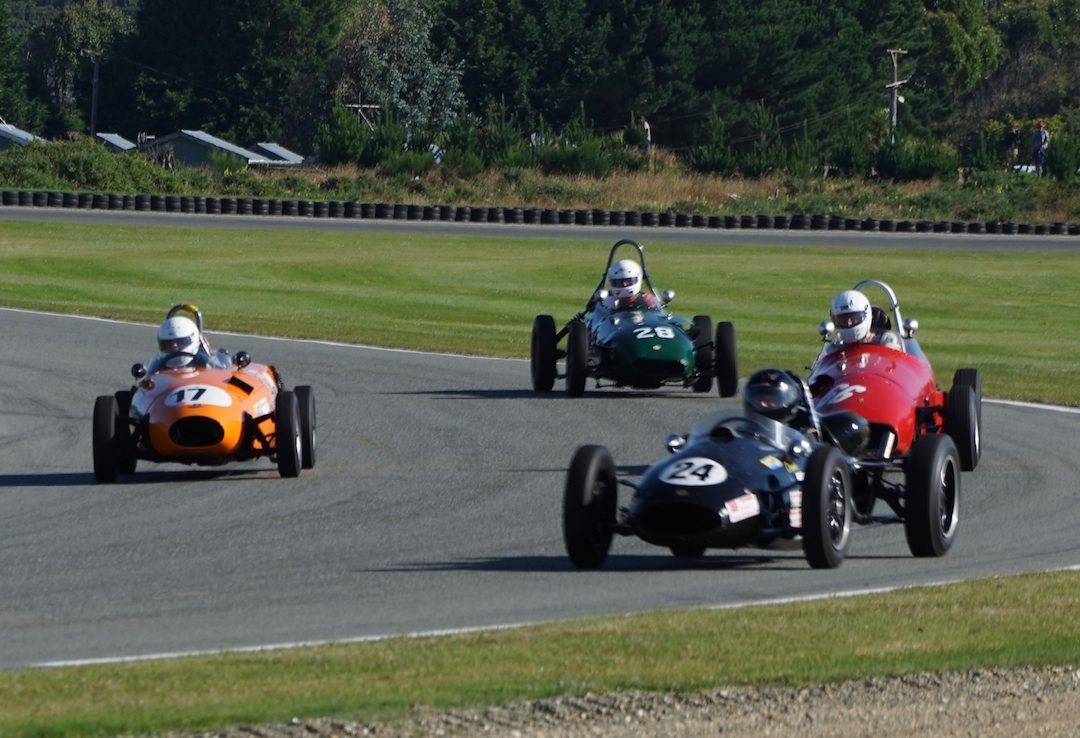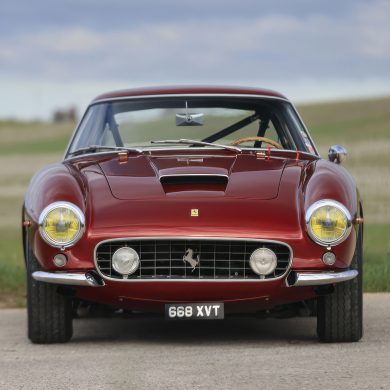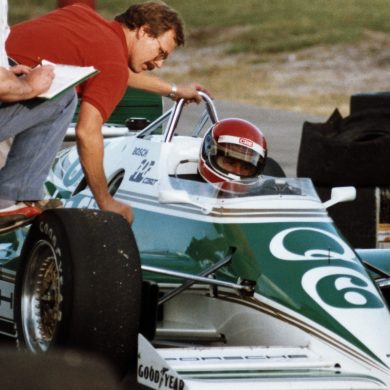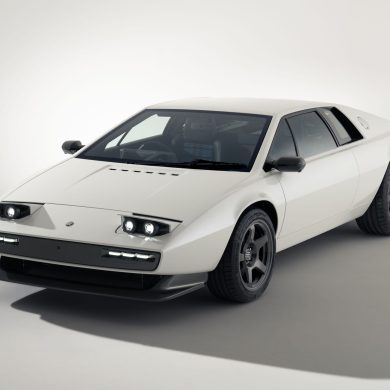The international Diamond Jubilee Formula Junior celebratory Tour, now on its way to North America, got rolling with five race meetings in New Zealand during the Southern Hemisphere summer. With 40 to 50 cars turning out at each of the five circuits hosting races, a huge impression was made with two full grids of historic cars at each venue.
New Zealand is, of course, the original home country of both Tour Patron and ex-Formula One and Formula Junior driver Howden Ganley, as well as 1967 F1 World Champion Denis Hulme, who had an extensive Formula Junior race history. Thus is it fitting that the award for winning the New Zealand segment was the Hulme Trophy.
Although the international FIA format normally divides races into front-and rear-engine categories, in New Zealand a better mix of cars, speeds and driver abilities was obtained by having the slower rear-engined cars mixed in with the front-engine machines. A round-by-round synopsis follows.
Round 1: Hampden Downs
The New Zealand opener was held at the newly extended Hampden Downs circuit, about an hour south of Auckland. At 3.8 kilometers it is now the longest, if not the fastest, circuit in the country. The Hampden Downs event also celebrated legendary Kiwi driver Kenny Smith’s lengthy and successful race career. Now 75, Smith still shows no sign of slowing down, and dominated the accompanying F5000 events in his Lola T332.
In the rear-engine FJ group UK entrant Greg Thornton (Lotus 22) was consistently 1st across the finish line, hotly pursued by Australian Martin Bullock in his immaculate Lotus 27. Next came New Zealander Noel Woodford (Gemini Mk3A), Brit Robin Longdon (Lola Mk5A) and South African David Innes in another well presented Lotus 27.
In the front-engine grouping, Dane Jac Nellemann set the early pace in his 1959 Danish-built Alfa Dana-BMC. He was chased hard by Kiwi Tony Olissoff in the Emeryson Elfin, also BMC-powered, who managed to pull back one win from the four races.
Round 2: Taupo
The tour then moved to Taupo in the central North Island, where the Bruce McLaren Motorsport Park circuit posed a number of challenges with its long straights and twisty infield. In the rear-engine class Greg Thornton and Marty Bullock again led the way, but some new names began to push forward in the later races, notably Peter Anstiss (UK/Lotus 20/22), David Watkins (Australia/Elfin) and Peter Boel (New Zealand/Lola Mk5A).
In the front-engined group, Jac Nellemann again held sway, but in the first race was hotly pursued by locals Peter Benbrook (Cooper T56) and Walter Findlay (Elva DKW). In the next race Australian Max Pegram (Gemini Mk2) pushed up to 2nd ahead of Benbrook and Findlay, and in the final two races Kiwi local Tony Olissoff (Emeryson Elfin) managed to get his car going again to push Nellemann pretty hard, as Scot Vern Williamson taking a good 3rd place in his Lynx T3.
Round 3: Ruapuna
The third event of the New Zealand Tour took place at the Ruapuna circuit near Christchurch in the South Island. This involved a five-hour drive from Taupo to catch the inter-island ferry at Wellington, and then, due to the November 2016 earthquake closing the coastal road via Kaikoura, taking the longer route over the Southern Alps through the Lewis Pass.
At Ruapuna, in the rear-engine class, Greg Thornton found some real competition from Marty Bullock, who came home 1st in two of the four races, while Noel Woodford (Gemini Mk3A), Robin Longdon ((Lola Mk5) and David Innes (Lotus 27) were not far behind. In the front-engine class Jac Nellemann was also faced with the field inching closer, as Kiwi Michael Sexton (Gemini Mk2) and American J.R. Mitchell (Lotus 18) each won one of the four races. Kiwi Paul Halford (Autosud) also began to make his presence felt in the top bunch, along with Colin Nursey (UK/Lotus 18) and Graham Barron (UK/Gemini Mk2).
Round 4: Timaru
From Ruapuna and Christchurch it was only a two-hour run by road down to Timaru for the ENZED Classic. Many of those who had opted for campervans as the primary means of travel were able to relax a bit and take in the non-racing aspects of the South Island. Timaru’s “Levels” circuit, at 2.4 kilometers, is the shortest of the New Zealand venues, but still very user friendly, although a couple of the corners did invite some faster-than-practical cornering, with several inevitable excursions onto the grass.
With Greg Thornton having returned to the UK, the rear-engine class became a bit of a party for Martin Bullock in the Lotus 27. Only Noel Woodford (Gemini Mk3A) managed to spoil this by winning one of the five races. Fellow Kiwi and ex-Formula Ford driver Phil Foulkes (Lotus 20/22) began, however, to edge closer with three 3rd places, indicating he was starting to get to grips with Formula Juniors.
Although Jac Nellemann in the Alfa Dana did not have it all his own way in the front-engine group, he still managed to win four of the five races. Michael Sexton in the silver Gemini Mk2 won the other, and Tony Olissoff in the Emeryson managed to push Nellemann back to 3rd in one race.
Round 5: Teretonga
Next came Invercargill and the Teretonga circuit, the oldest in New Zealand, dating back to 1956, and also the world’s southernmost motor racetrack. Once again the campervan crowd was able to take advantage of some great scenery and camping opportunities before arriving at the circuit for Friday practice.
Brilliant weather for this southernmost circuit belied its often chilly environment, and Australian Marty Bullock’s Lotus 27 made it four out of four races in the rear-engine class, but Kiwi Phil Foulkes (Lotus 20/22) notched up a couple of 2nd–place finishes and a 3rd, to join fellow local Noel Woodford among those hard on Bullock’s heels.
In the front-engine group Kiwi Tony Olissoff in the Emeryson pulled off two wins from four races, but it was clear that nothing was going to stop the flying Dane Jac Nellemann and the Alfa Dana from being declared overall winner and recipient of the Hulme Trophy.
At all rounds much of the interest was again found among those in the bottom half of the field, all having their own battles, with a mix of fascinating cars including Duncan Rabagliati in the Alexis HF1, Tony Pearson in the Bandini Fiat, Brian Searles in the Panther Mk1, Kevin Anderson’s Cooper T52 and Richard Bishop-Miller’s Autosport Equip Mk2. Apart from some rain on one day at Hampden Downs, the racing was undertaken in a great spirit and marvellous conditions. The 40-50 FJs at every event was also a magnificent sight, and the relaxed low-key environment encouraged enthusiasts to mix with drivers and supporters to talk about their cars and historic racing.
North America beckons!










